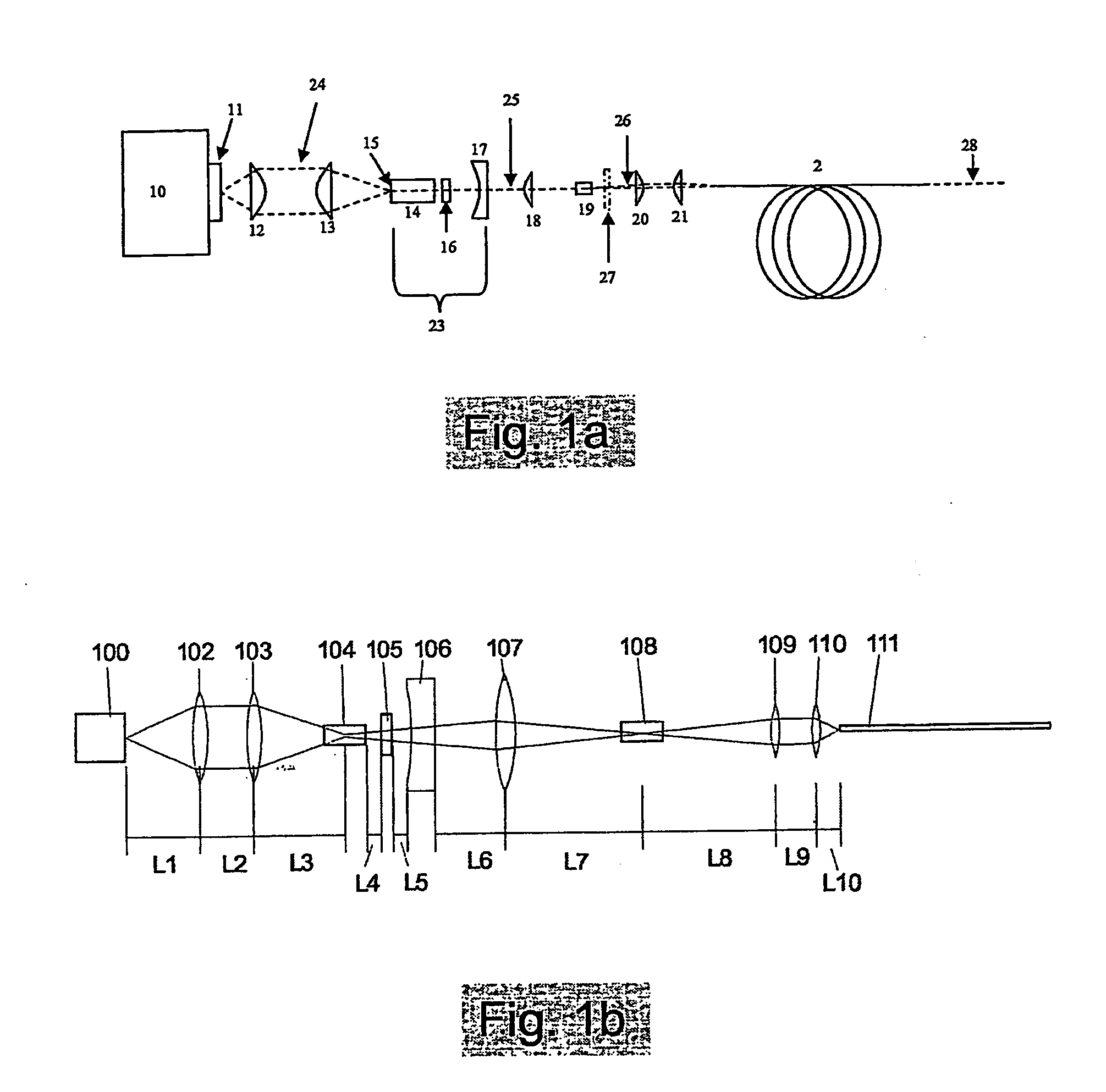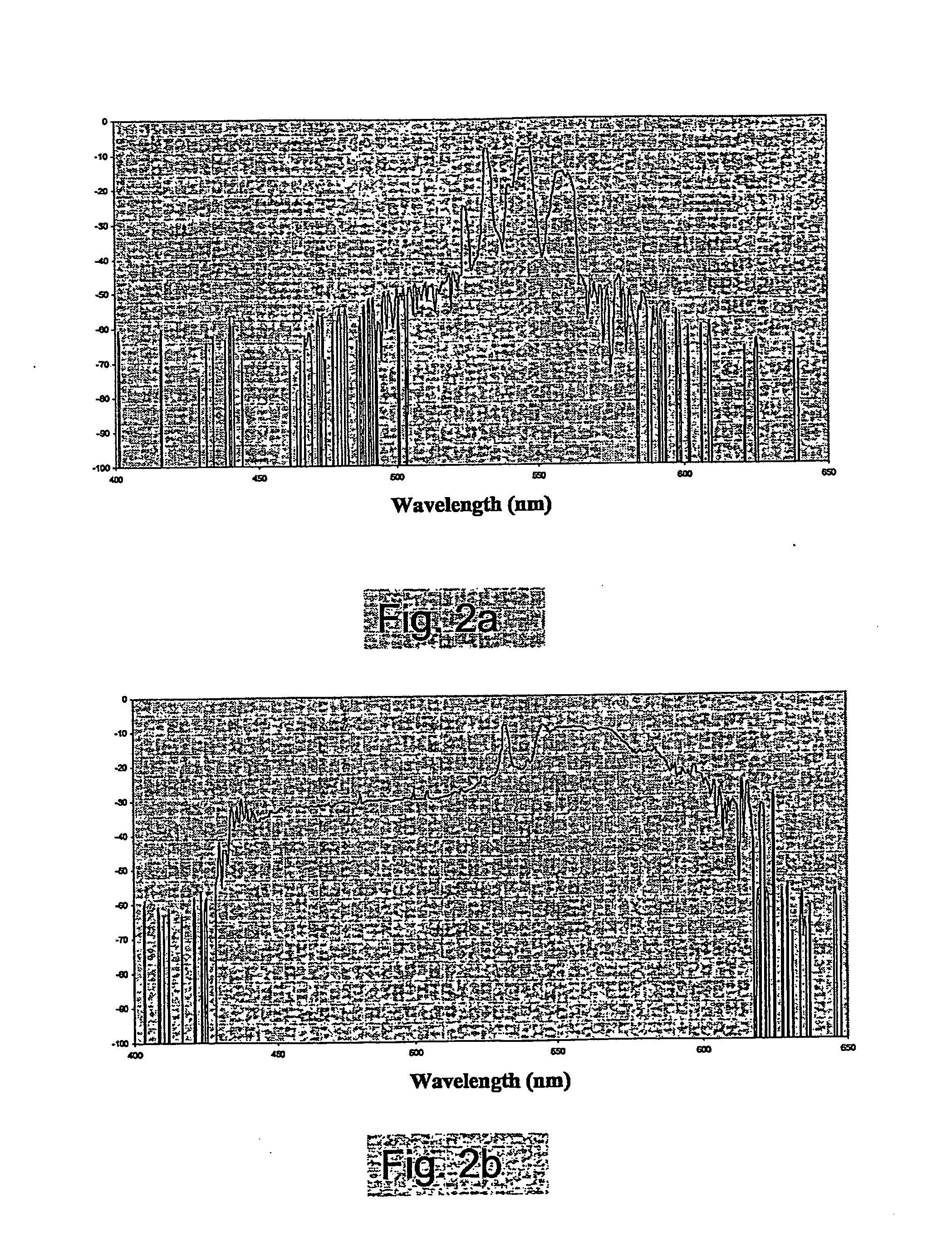Method of Generating Supercontinuum Optical Radiation, Supercontinuum Optical Radiation Source, and Use Thereof
a supercontinuum optical radiation and optical radiation source technology, applied in the field of generating supercontinuum optical radiation and supercontinuum optical radiation sources, can solve the problems of low efficiency and supercontinuum extended as short as 400 nm, and achieve the effect of large bandwidth and cost reduction
- Summary
- Abstract
- Description
- Claims
- Application Information
AI Technical Summary
Benefits of technology
Problems solved by technology
Method used
Image
Examples
example 1
[0093]Comparison Output Spectra—a Single Laser Radiation
[0094]FIG. 2a shows a comparison example of the visible portion of the output spectrum of a photonic crystal fibre pumped with laser radiation of a single wavelength.
[0095]The output spectrum of the light 28 exiting the optical fibre 22, here a NL 740 supplied by Crystal Fibre, Denmark has been measured with an ANDO optical spectrum analyzer for the case where the optical fibre has been pumped with laser radiation of only the second harmonic light 26. In this case the fundamental light 25 was blocked by an optical filter 27 which is substantially transmissive for the second harmonic light 26 and substantially reflective for the fundamental light 25 so that virtually no fundamental light 25 enters the optical fibre 22.
example 2
[0096]Comparison Output Spectra—Two Laser Radiations
[0097]FIG. 2b shows an example of the visible portion of the output spectrum of the photonic crystal fibre used for FIG. 2a pumped with laser radiations of two wavelengths according to the invention.
[0098]The output spectrum of the light 28 exiting fiber 22 shows that the addition of light 25, which is infrared, has the unexpected result of generating a broad visible supercontinuum when the fibre 22 is pumped by both the fundamental light 25 and second harmonic light 26.
[0099]FIG. 3 shows an example of the complete output spectrum of the photonic crystal fibre used for FIG. 2a pumped with two wavelengths according to the invention; the output spectrum of the light 28 exiting the fiber 22 covering the visible and infrared portions of the spectrum.
example 3
[0100]Dispersion Parameter—Wavelength Selection for a Photonic Crystal Fibre
[0101]FIG. 4 shows the dispersion parameter versus wavelength of the photonic crystal fibre used for FIG. 2a according to an embodiment of the present invention.
[0102]As seen form FIG. 4, the dispersion parameter at the shorter wavelength (532 nm) is positive β22 but numerically smaller than the dispersion parameter β21 at the wavelength (1064 nm). Thus, the sum of dispersion parameters β21+β22 of the dispersion parameters β21 and β22 is negative and consequently, the dispersion factor is negative.
[0103]For operation, this negative dispersion factor can be balanced by adjusting the power factor by adjusting the powers P1 and P2 for the two applied laser radiations. Thus the present photonic crystal fibre can be used for dual wavelength pumped continuum generation according to the invention, e.g. using the system shown in FIG. 1a.
[0104]It should be noted that for particularly long fibres wherein the walk-off...
PUM
 Login to View More
Login to View More Abstract
Description
Claims
Application Information
 Login to View More
Login to View More - R&D
- Intellectual Property
- Life Sciences
- Materials
- Tech Scout
- Unparalleled Data Quality
- Higher Quality Content
- 60% Fewer Hallucinations
Browse by: Latest US Patents, China's latest patents, Technical Efficacy Thesaurus, Application Domain, Technology Topic, Popular Technical Reports.
© 2025 PatSnap. All rights reserved.Legal|Privacy policy|Modern Slavery Act Transparency Statement|Sitemap|About US| Contact US: help@patsnap.com



